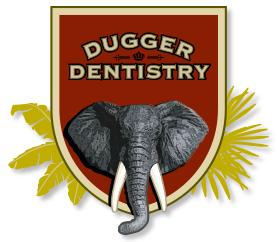Leave it to Beaver?… Dental Enamel, at Least

If you ever see a beaver’s teeth, you might think that they appear rotten. That’s because beavers– along with other members of the order Rodentia— have huge orange-colored incisors, and in humans orange teeth means: clean me, I’m a mess!
But for beavers, that orange color is actually part of what makes their teeth so strong, and, as scientists are learning, it is also responsible for making beaver enamel harder and more resistant to corrosion than human enamel. The secret to beaver enamel’s strength and color is: iron.
A word about enamel
Our dental enamel is the hardest substance in our bodies. It is the outermost layer on our teeth, and it serves to protect teeth from wear, tear, and decay. Unfortunately, while enamel is extremely tough against most things, it is also vulnerable to acids found in drinks and the metabolic waste of bacteria that live in our mouths. Acid attacks on enamel eventually lead to a hole in the enamel surface– a cavity.
From a firm foundation
The structure of dental enamel, according to scientists, is incredibly complex. Researchers studying the enamel of rodents have broken down the enamel structure into two basic components: layers of hydroxylapatite forming rock-solid “nano-wires,” surrounded by an “amorphous matrix” of different minerals, including iron and magnesium.
In terms of structure, our teeth and beavers’ have the same hydroxylapatite “nanowires.” It is the amorphous matrix differences that place beavers’ teeth in an entirely different class when it comes to hardness and resistance to acid.
This just in
Using tomography and other imaging techneqes, scientists studied the structure of tooth enamel down to the level of the atoms present in enamel’s “amorphous matrix” to better learn how beaver teeth have harder enamel.
Scientists believe it is the small ions present in this matrix that make up the difference in hardness and acid resistance between beaver teeth and human teeth. For our enamel, one of the key ions present is magnesium, and in beaver enamel, the ion is iron. This iron does make beaver teeth look orange, but it’s way better at chewing up trees!
The research continues
The researchers published their analysis of enamel’s “amorphous matrix” in this month’s issue of Science. There’s much more to learn about dental enamel, but we do know quite a bit right now that can really contribute to oral health.
Follow these steps for enamel health:
- Enamel is vulnerable to acid attacks from bacteria (and sugary drinks), so be sure to brush and floss regularly.
- Speaking of drinks, it’s best to avoid high sugar, acidic drinks like sports drinks or soda. These not only feed bacteria, but the low pH of the drink itself starts eating at your enamel before you’ve even swallowed!
- Drink plenty of water. Water helps neutralize pH and clean the mouth.
- Chew sugar-free gum after a meal. It stimulates saliva, which is also responsible for neutralizing the oral pH. In addition, saliva carries ions that works to remineralize damaged enamel.
- Talk to your West Linn dentist about fluoride treatments– this is a potential tool to help protect and rebuild enamel.
Schedule your appointment now to learn more about dental enamal and how we can work with you to protect this critical oral health asset!
Photo Credit: indiana.dunes via Compfight cc
